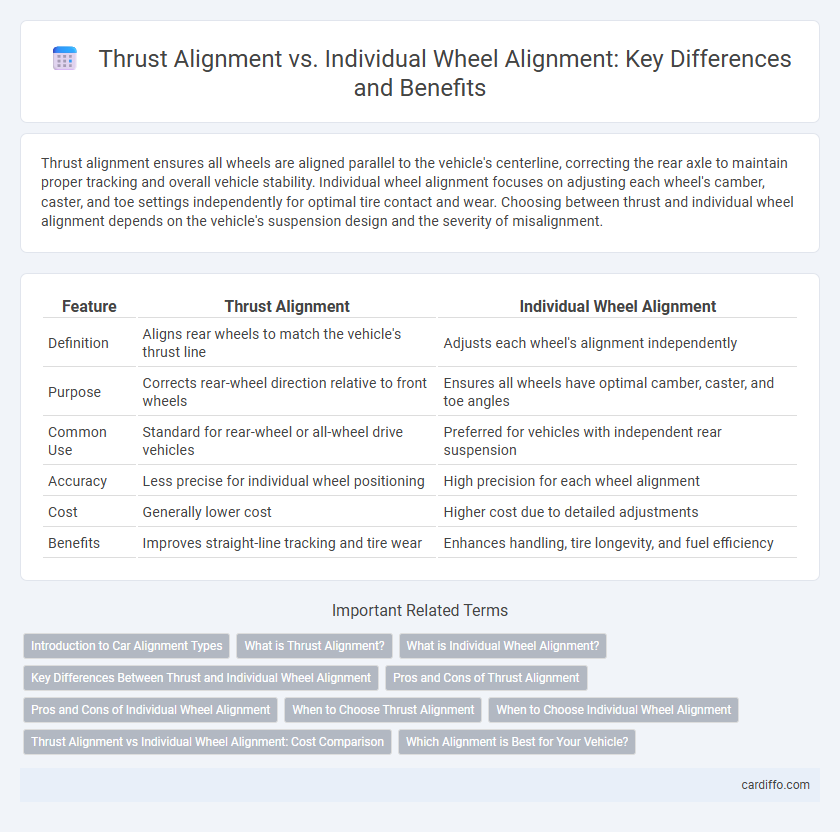Thrust alignment ensures all wheels are aligned parallel to the vehicle's centerline, correcting the rear axle to maintain proper tracking and overall vehicle stability. Individual wheel alignment focuses on adjusting each wheel's camber, caster, and toe settings independently for optimal tire contact and wear. Choosing between thrust and individual wheel alignment depends on the vehicle's suspension design and the severity of misalignment.
Table of Comparison
| Feature | Thrust Alignment | Individual Wheel Alignment |
|---|---|---|
| Definition | Aligns rear wheels to match the vehicle's thrust line | Adjusts each wheel's alignment independently |
| Purpose | Corrects rear-wheel direction relative to front wheels | Ensures all wheels have optimal camber, caster, and toe angles |
| Common Use | Standard for rear-wheel or all-wheel drive vehicles | Preferred for vehicles with independent rear suspension |
| Accuracy | Less precise for individual wheel positioning | High precision for each wheel alignment |
| Cost | Generally lower cost | Higher cost due to detailed adjustments |
| Benefits | Improves straight-line tracking and tire wear | Enhances handling, tire longevity, and fuel efficiency |
Introduction to Car Alignment Types
Thrust alignment ensures all wheels are aligned with the vehicle's centerline by correcting rear axle positioning, providing a stable driving experience and preventing uneven tire wear. Individual wheel alignment adjusts each wheel independently, focusing on camber, caster, and toe angles for precise handling and improved tire performance. Understanding these alignment types helps optimize vehicle stability, steering response, and extends tire life.
What is Thrust Alignment?
Thrust alignment measures the rear axle's angle relative to the vehicle's centerline to ensure all wheels point in the correct direction for stable handling. This process adjusts the rear wheels simultaneously, aligning them with the vehicle's thrust line created by the front wheels' direction. Unlike individual wheel alignment, thrust alignment focuses on rear wheel conformity to maintain proper tracking and minimize uneven tire wear.
What is Individual Wheel Alignment?
Individual wheel alignment refers to the precise adjustment of each wheel's angles, including camber, caster, and toe, to ensure optimal contact with the road surface. Unlike thrust alignment that aligns the rear wheels to the vehicle's centerline, individual wheel alignment treats each wheel independently, correcting specific misalignments for enhanced handling and tire wear. Accurate individual wheel alignment improves vehicle stability, steering response, and extends tire lifespan by addressing uneven tire wear patterns.
Key Differences Between Thrust and Individual Wheel Alignment
Thrust alignment adjusts the rear wheels to align with the vehicle's centerline and the front wheels, ensuring overall directional stability and preventing the car from pulling to one side. Individual wheel alignment, on the other hand, involves setting the camber, caster, and toe angles for each wheel independently to optimize tire wear, handling, and steering response. The key difference lies in thrust alignment focusing on the rear axle's relationship to the front wheels, while individual wheel alignment targets precise adjustments for every single wheel.
Pros and Cons of Thrust Alignment
Thrust alignment ensures all wheels are aligned perpendicular to the vehicle's centerline by aligning the rear wheels to the thrust angle, which improves straight-line stability and reduces tire wear on vehicles with rear-wheel misalignment. It is a cost-effective method for maintaining proper alignment on vehicles with minor rear suspension issues but may not address individual wheel problems caused by suspension damage or uneven tire wear. However, thrust alignment can result in suboptimal handling and uneven steering response if individual rear wheels are out of alignment.
Pros and Cons of Individual Wheel Alignment
Individual wheel alignment offers precise adjustment tailored to each wheel, enhancing vehicle handling and tire longevity. It allows correction of specific wheel misalignments caused by suspension damage or uneven tire wear, improving overall safety and ride comfort. However, this method can be more time-consuming and costly compared to thrust alignment, and may not address underlying issues if the rear axle is misaligned.
When to Choose Thrust Alignment
Thrust alignment is ideal when a vehicle exhibits uneven tire wear or steering pulls to one side, indicating misalignment of the rear wheels relative to the front. This method ensures all wheels are aligned to the vehicle's thrust line, correcting the rear axle's angle and improving overall handling and tire longevity. Choose thrust alignment over individual wheel alignment when rear-end damage or suspension issues affect the rear wheels' positioning.
When to Choose Individual Wheel Alignment
Individual wheel alignment is ideal when a vehicle exhibits uneven tire wear or pulling to one side, indicating that a full thrust alignment may not address all issues. It targets specific misalignments in each wheel, optimizing steering precision and tire lifespan. Choosing individual wheel alignment is especially important for vehicles with independent suspension systems or after repairs affecting a single wheel.
Thrust Alignment vs Individual Wheel Alignment: Cost Comparison
Thrust alignment typically costs less than individual wheel alignment because it adjusts the rear wheels in relation to the front, requiring less time and fewer adjustments. Individual wheel alignment involves precise calibration of all four wheels independently, increasing labor and parts expenses. Choosing thrust alignment offers a budget-friendly solution for vehicles without advanced suspension systems, while individual alignment ensures optimal handling but at a higher price point.
Which Alignment is Best for Your Vehicle?
Thrust alignment accurately sets the rear wheels perpendicular to the vehicle's centerline, providing better stability for vehicles with solid rear axles, while individual wheel alignment independently adjusts each wheel to optimize tire wear and steering precision. Vehicles with independent rear suspension benefit more from individual wheel alignment due to its precise calibration of camber, caster, and toe angles on all wheels. Selecting the best alignment depends on your vehicle's suspension type and driving conditions, with thrust alignment suited for trucks and SUVs and individual wheel alignment ideal for passenger cars and performance vehicles.
Thrust Alignment vs Individual Wheel Alignment Infographic

 cardiffo.com
cardiffo.com